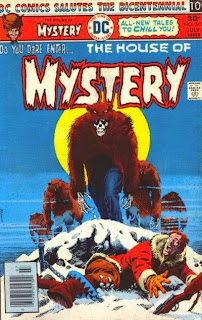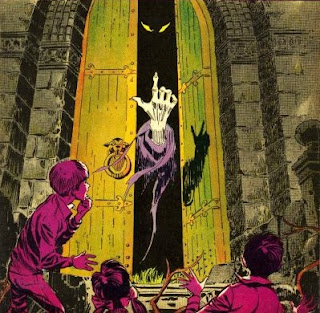The DC Mystery Anthologies 1968-1976
by Peter Enfantino and
Jack Seabrook
Jack Seabrook
 |
| Ricardo Villagran |
"Brother Bear"
Story by Bob Haney
Art by Franc C. Reyes
"Things Like That Don't Happen"
Story by Sheldon Mayer
Art by Jess Jodloman
Peter: Hunter/tycoon Zebulon Hunt is sentenced to die by electric chair but... for what crime? In a flashback we see that Hunt has a penchant for polar bears and their skins; in fact, he's dressed his entire mansion with pelts and heads. His manservant, Umiak, tells Zeb that he should not be hunting polar bears anymore as it will bring bad juju but the tyrant won't listen. When Zeb jumps in and nails a bear that Umiak was hunting (in an admirable fashion), the gods are disturbed and a price must be paid. Umiak disappears but that doesn't keep the great hunter from his fun and, while out on the frozen tundra, the biggest polar bear ever to cross Zebulon's path practically gives itself up to him. Zeb takes advantage of the free pass and then lops off the head and walks it down to the taxidermist. That's where the trouble starts. Though "Brother Bear" is a variation on a theme we've seen before (several times in a jungle setting with Alfredo Alcala art), Bob Haney (whose work we've been critiquing in our DC War room) manages to pull this one off. I especially liked the fact that, when the payoff comes, Umiak's noggin is never seen, only gasped at, a subtlety we don't see often in these here parts.
Jack: I preferred the second story, "Things Like That Don't Happen," in which a Boardwalk Gypsy King fortune teller machine gets revenge by murdering the no good husband of a decent woman. Jess Jodloman's art is always a bit on the scratchy side but I've gotten used to it, and any story that involves a Boardwalk fortune telling machine already has a leg up in my book. Millie, the gal who is killed, shows admirable skill when she picks the lock on the machine to prop up the Gypsy King after he suddenly falls over.
 |
| Something sexual about this panel! |
 |
| Luis Dominguez |
"The Mark of a Murderer"
Story by Carl Wessler
Art by E.R. Cruz
"Mirror of Madness"
Story by George Kashdan
Art by Buddy Gernale
"My Mother Was a Witch!"
Story by Carl Wessler
Art by John Calnan
Jack: Poor Julie Burrows! After her father walked out on her and her mother when she was just eight years old, the other kids at school started to pick on her. Good thing she could say that "My Mother Was a Witch!" Mom waves her hand and the bullies regret their behavior. The same fate awaits teachers and parents who don't mind their manners. Two years later, Julie's Mom dies and the girl is sent to an orphanage, where she retaliates against the cruel matron with a little witchcraft of her own. Finally, Dad comes to retrieve her, revealing that he's a warlock and little Julie takes after her old man--Mom was never a witch after all! Wessler and Calnan combine to create a story that barely edges out the other two travesties in this, another forgettable issue of The Witching Hour.
Peter: Wessler and Calnan combine to create a story certain to top my "Worst of the Year" list. Wessler's script is inane but Calnan's amateurish chicken scratches seal the deal. Just plain ugly. Nothing about this story made sense. Julie's dad is sent away by her mom because her mother didn't want anyone to know he was a warlock? Why wouldn't she let dad hang around and help Julie master her skills? Wouldn't that make more sense? None of the stories this issue have a twist ending. They just end. If there's one speck of respectability here, it lies in the artwork E.R. Cruz delivers for "The Mark of a Murderer." Nicely atmospheric. Otherwise, it's the usual issue of The Wretched Hour.
 |
| Luis Dominguez |
"Gauntlet of Fear"
Story by George Kashdan
Art by Don Perlin
"Sands of Time"
Story by uncredited
Art by Rich Buckler
"The Long Arms of Death"
Story by Weshley Marsh (Murray Boltinoff)
Art by Fred Carrillo
Jack: Gerald left England to become secretary to a wealthy man in India, but all he can think about is the man's pretty but lonely daughter, Kaleli. Ignoring the father's warnings to stay away from his daughter, Gerald turns on the charm and before you know it he tells Pop he wants to marry the gal. Oddly enough, she never wants to go for a swim, or dance, or basically do anything involving removing her shawl. Gerald tells Kaleli he bought airline tickets for the both of them and, when he robs her Dad's safe, he is surprised by his employer, who tells him to keep the cash but leave the girl alone. Gerald kills the boss and is attacked by his bodyguards, but soon Kaleli grabs them and Gerald sees that she is Kali, the ten-armed goddess. She does not cotton to his suggestion that they go to London and have eight of her arms removed by a surgeon, so she gives him a great big ten-armed hug and crushes him to death.
"The Long Arms of Death" is easily the most fun story in this issue of Unexpected, which also features a dreadful entry by Kashdan and Perlin and a two-page flop by Rich Buckler.
 |
| How many arms does she have on the cover? |
Peter: With the cover illustration and a "stunning beauty" named Kaleli, I sure never saw that shock ending coming! But I thought the highlight of the issue was the delightfully dumb "Gauntlet of Fear," in which psychiatrist Dr. Terrell is hired by the President of a "remote tiny republic" to help soothe his fears of assassination. The doc is kidnapped by The Great Bajir, an evil and rotund terrorist whose goal is to brainwash the headshrinker into murdering the President. Bajir's personal fear of dirt (!) becomes his undoing in the end. "Gauntlet" has a script that's one part Man From U.N.C.L.E. and six parts dopiness and art by one of the crown princes of mediocrity that suits its inanity. Hell, at least it's a lot more fun than 90% of the swill that's being presented as professional comic book material this month.
 |
| Luis Dominguez |
"Kronos--Zagros--Eborak!"
Story by George Kashdan
Art by Frank Thorne
"Your Epitaph is Only a Birthday Card"
Story by Doug Moench
Art by Frank Reyes
Peter: Doug Moench gives us a little bit of the deep preaching he became famous for over at Marvel with "Your Epitaph..." Two men discuss reincarnation and the afterlife in a hospital waiting room while, unbeknownst to them, a barbarian's soul drifts through space, waiting to be reborn. In the end, one man's friend dies a peaceful death and the other becomes a father (to a very young barbarian, no doubt). The reason why Moench's near-sermon about how to live life works here whereas it never worked in, say, his awful contributions to the Frankenstein series in Monsters Unleashed, is that, by 1976, the writer had honed his skills. Sure, there's a bit of the pretentiousness found in his Marvel work but, seemingly, Moench had finally learned to rein in not only his purple prose but also his firm belief that the world was going to hell in a bucket and everyone was out to get the young man. I'm more open to listening to the message if I don't think the messenger is full of shit. The issue's opener, "Kronos--Zagros--Eborak," about a lawyer in the Public Defender's office who's assigned to investigate a satanic worship ring, sports nice visuals from newcomer Frank Thorne (whose work on Red Sonja is being discussed, as we speak, over at Marvel University) and a clever twist in the tale. Overall, a decent issue of House of Mystery.
Jack: I liked the Frank Thorne story and I, too, was surprised by the twist ending. The only laugh out loud moment for me was the disguise worn by the lawyer when he goes to investigate the satanic cult--he looks like Huggy Bear from Starsky and Hutch! The Moench story seemed preachy and obvious to me, and the art made me long for the good old days when Gil Kane drew the sword and sorcery stories for the DC horror line.
 |
| Lawyer in disguise |
 |
| Huggy Bear |
 |
| Luis Dominguez |
"Showdown with a Specter"
Story Uncredited
Art by Tenny Henson
"The Phantom Head"
Story Uncredited
Art by Buddy Gernale
"The Girl Who Inherited a Ghost"
Story Uncredited
Art by Gene Ureta
Jack: In the summer of '68, Villem Kruger takes his wife and little boy to a remote part of South Africa, where he explores the rubble that remains of his late grandfather's diamond mine. Little does he know that he's about to have a "Showdown with a Specter!" The ghost is that of a laborer who died when the mine caved in, and he vows revenge on Villem, the grandson of the cruel mine owner. That night, Villem's son Jan disappears, and Villem follows him into the mine, where he is confronted by the specter. The boy volunteers to sacrifice himself in place of his father, but the ghost reveals that the boy is adopted and thus not a blood relative to the mine owner of long ago. Impressed by the boy's courage and by the father's willingness to adopt a child, the ghost decides to let bygones be bygones and heads off to his final rest.
 This is one of several stores we've seen that are drawn by Tenny Henson, and it looks like the work of a young artist with a lot of promise. At this stage in his career, Henson's strength seems to be in portraying beautiful blondes! I liked this story a lot, especially the ending where the ghost changed his mind and respected the kindness and self-sacrifice of Villem and his son. This was my favorite story of this two-month period.
This is one of several stores we've seen that are drawn by Tenny Henson, and it looks like the work of a young artist with a lot of promise. At this stage in his career, Henson's strength seems to be in portraying beautiful blondes! I liked this story a lot, especially the ending where the ghost changed his mind and respected the kindness and self-sacrifice of Villem and his son. This was my favorite story of this two-month period.One other comment--I think "Gene Ureta," who signed the last story in this issue, must be a pseudonym. The art is very strong and has echoes of Gene Colan as well as some panels that look like Neal Adams stopped by to ink them. "Gene Ureta" has no other credits anywhere. Ever.
Peter: Other than the decent art of Tenny Henson, there's not a lot to get excited by in this issue of Ghosts. "The Phantom Head" is another of those stories I would imagine was scribed by the most prolific of Ghosts' writers, Leo Dorfman. I can imagine Dorfman, sitting in his office, opening Encyclopedia Britannica volumes with his eyes closed, and pointing his finger at some random subject. In this case, Leo's finger stopped on Michelangelo.
 |
| The Second Flight of Enemy Ace! Exclusively in the 71st Issue of Star Spangled DC War Stories! On Sale February 1st! |







































